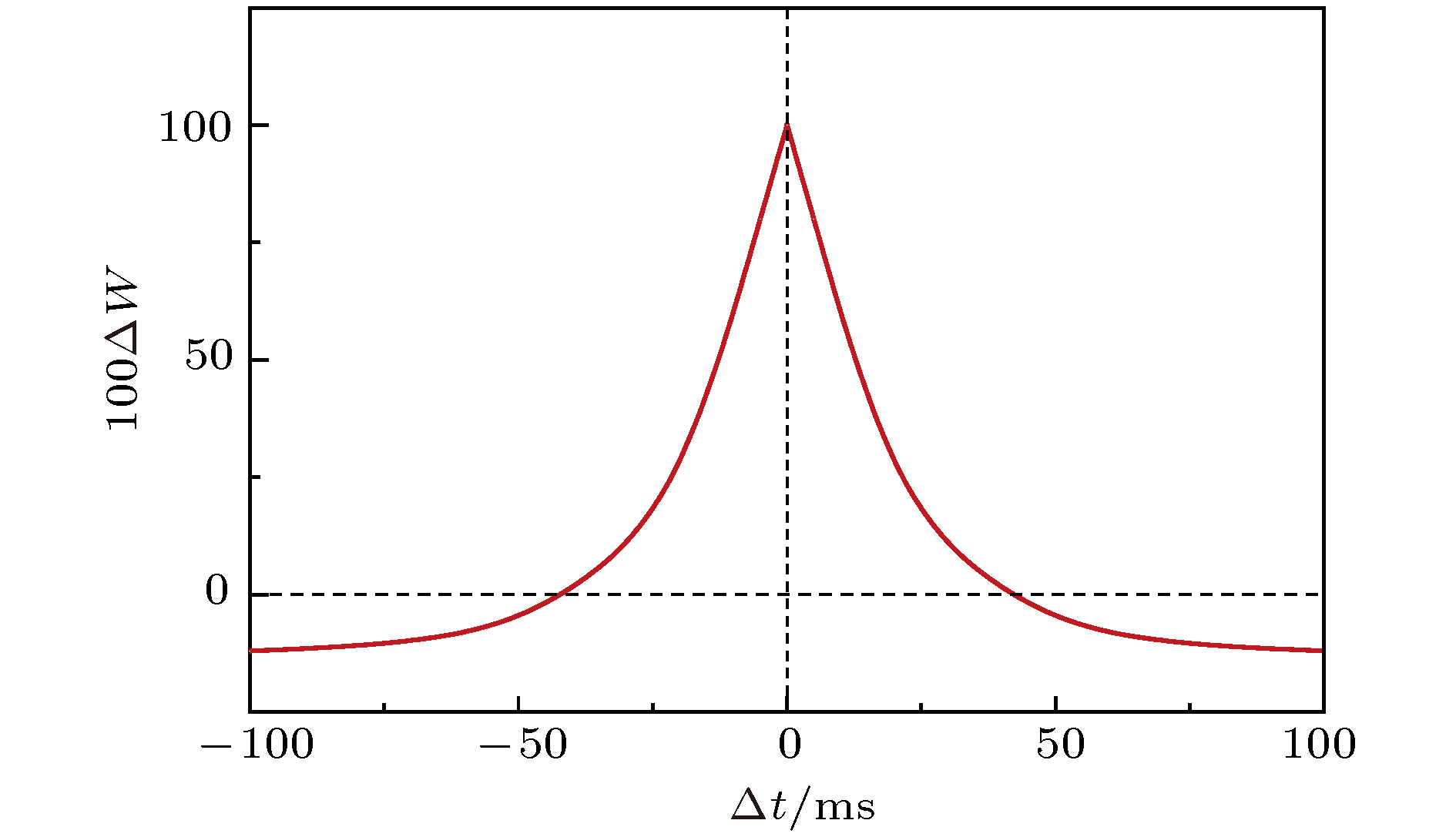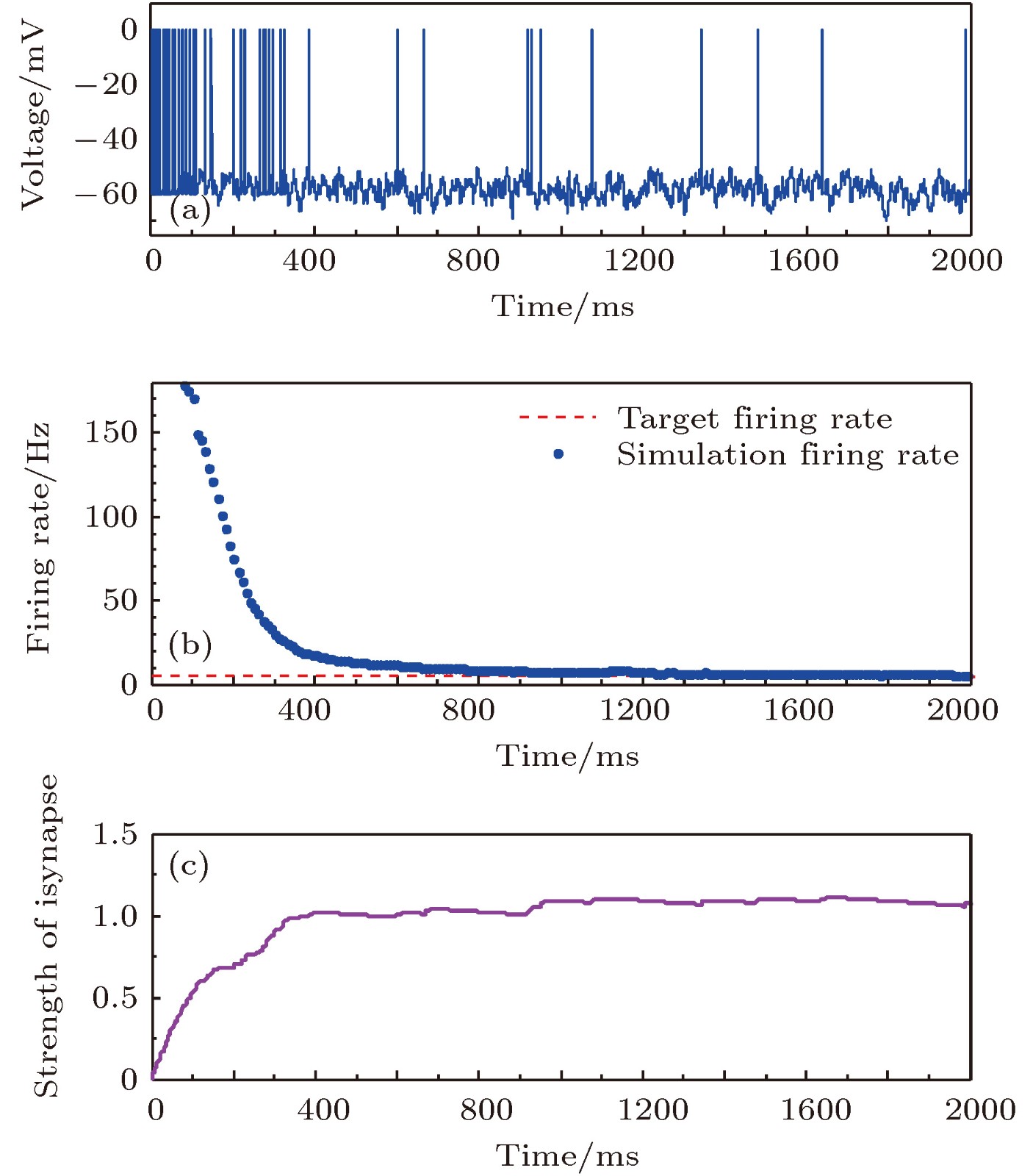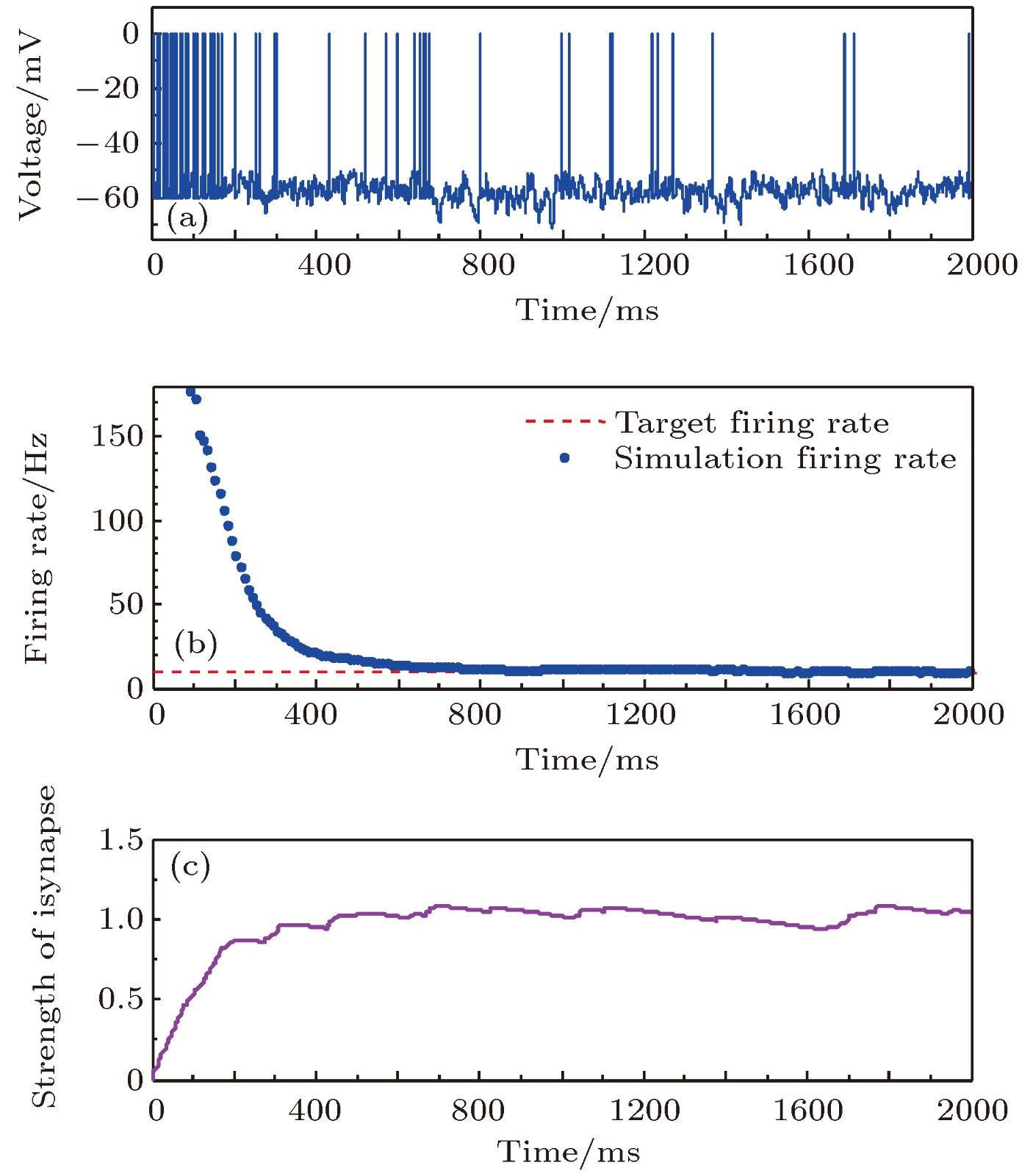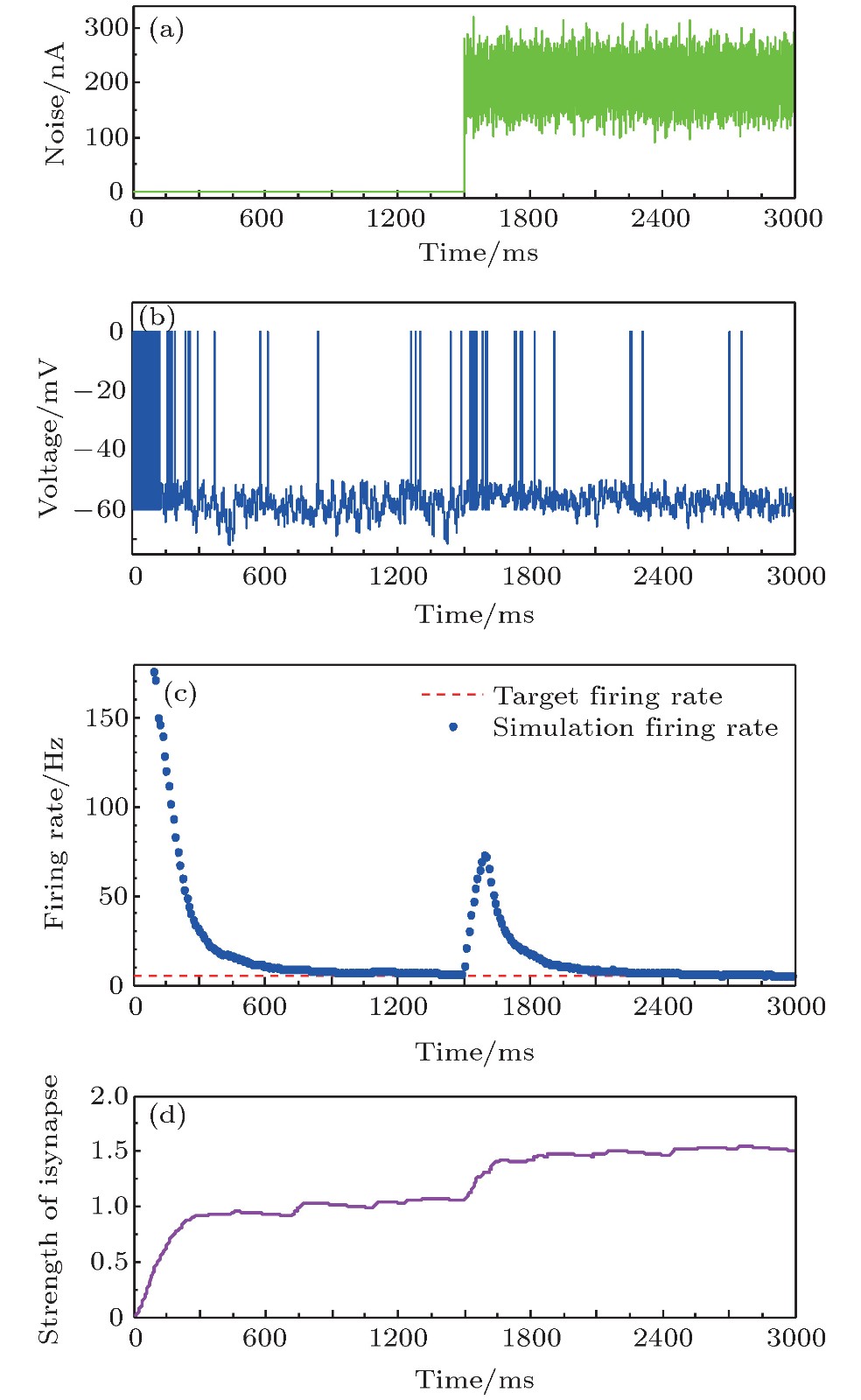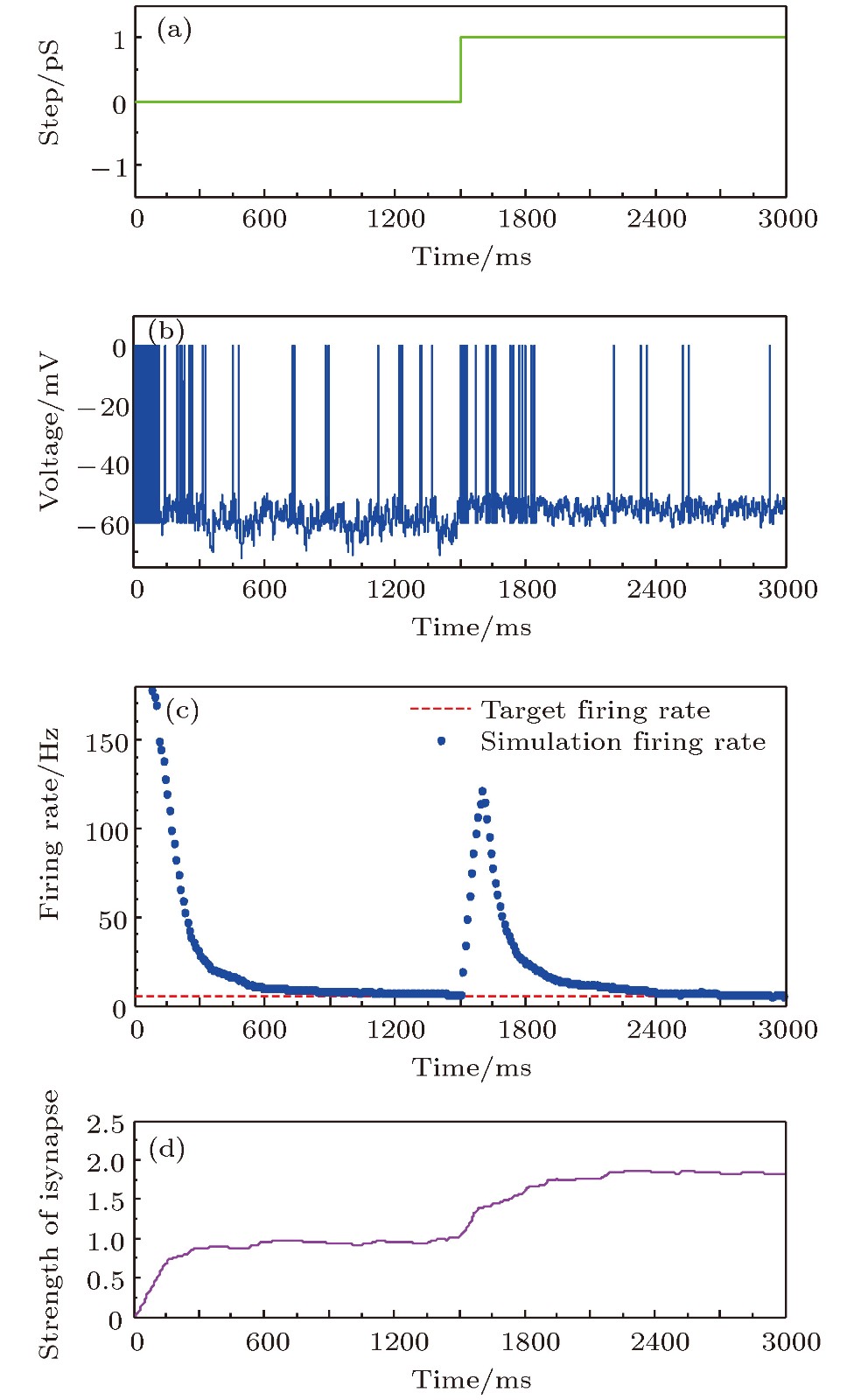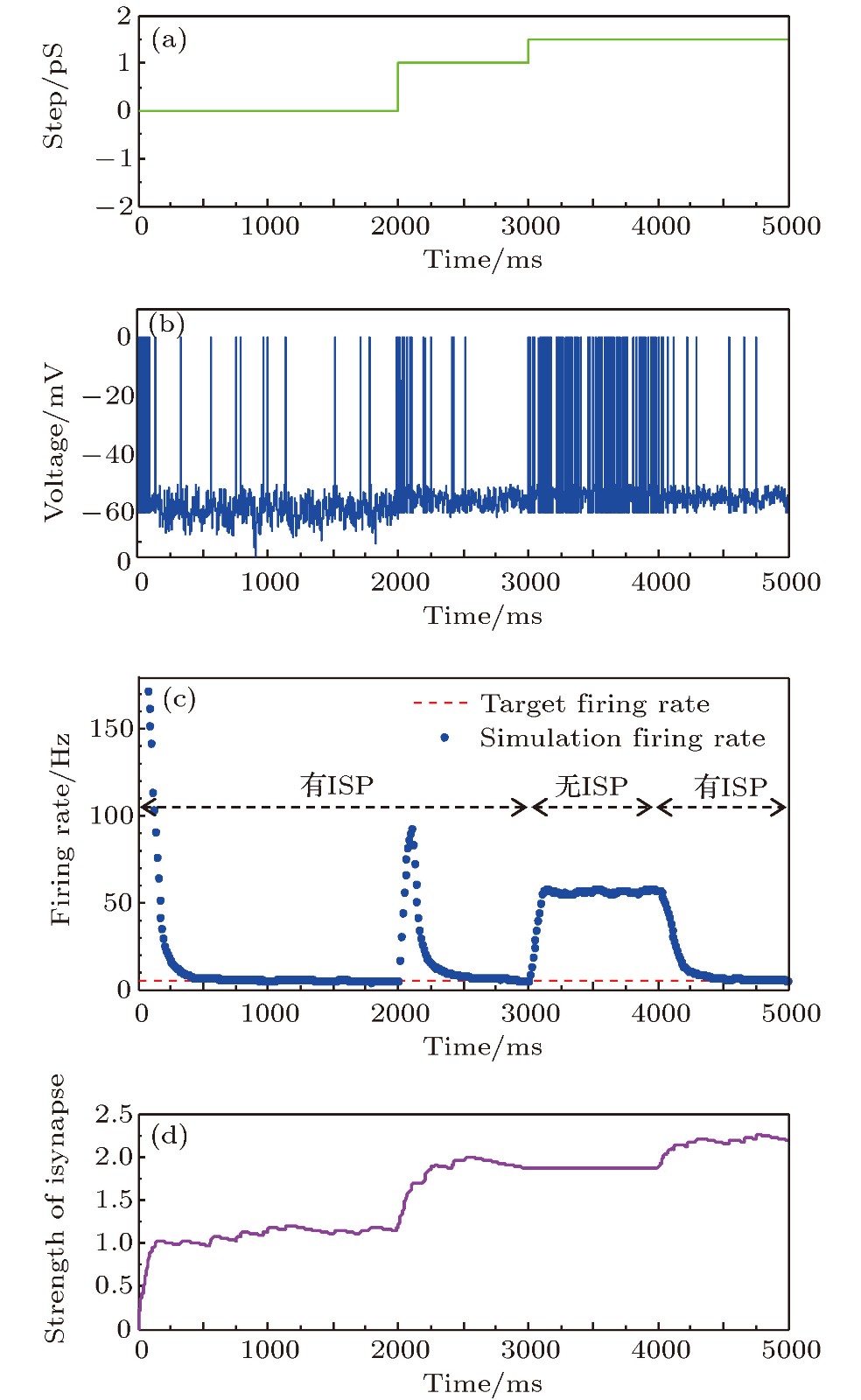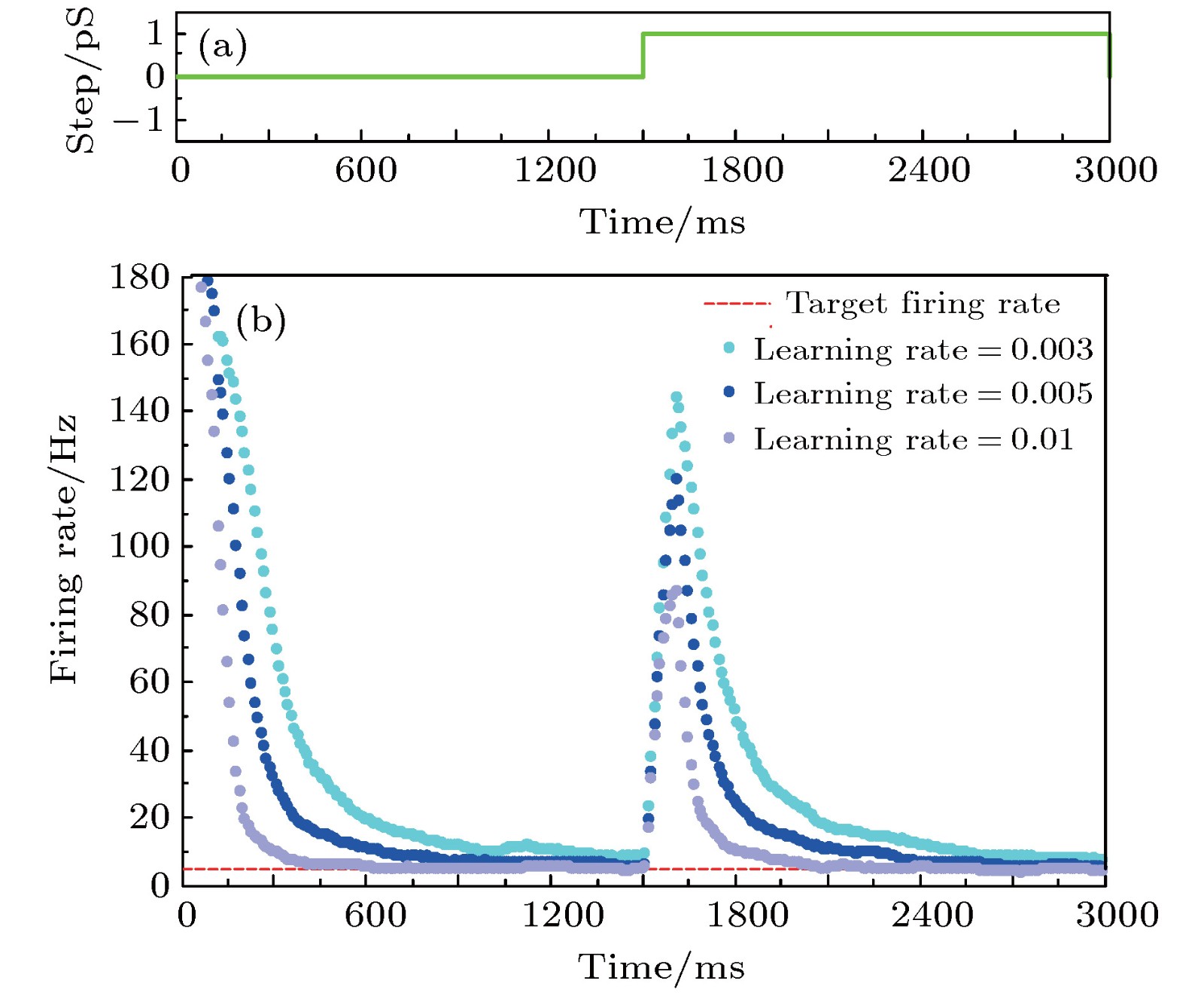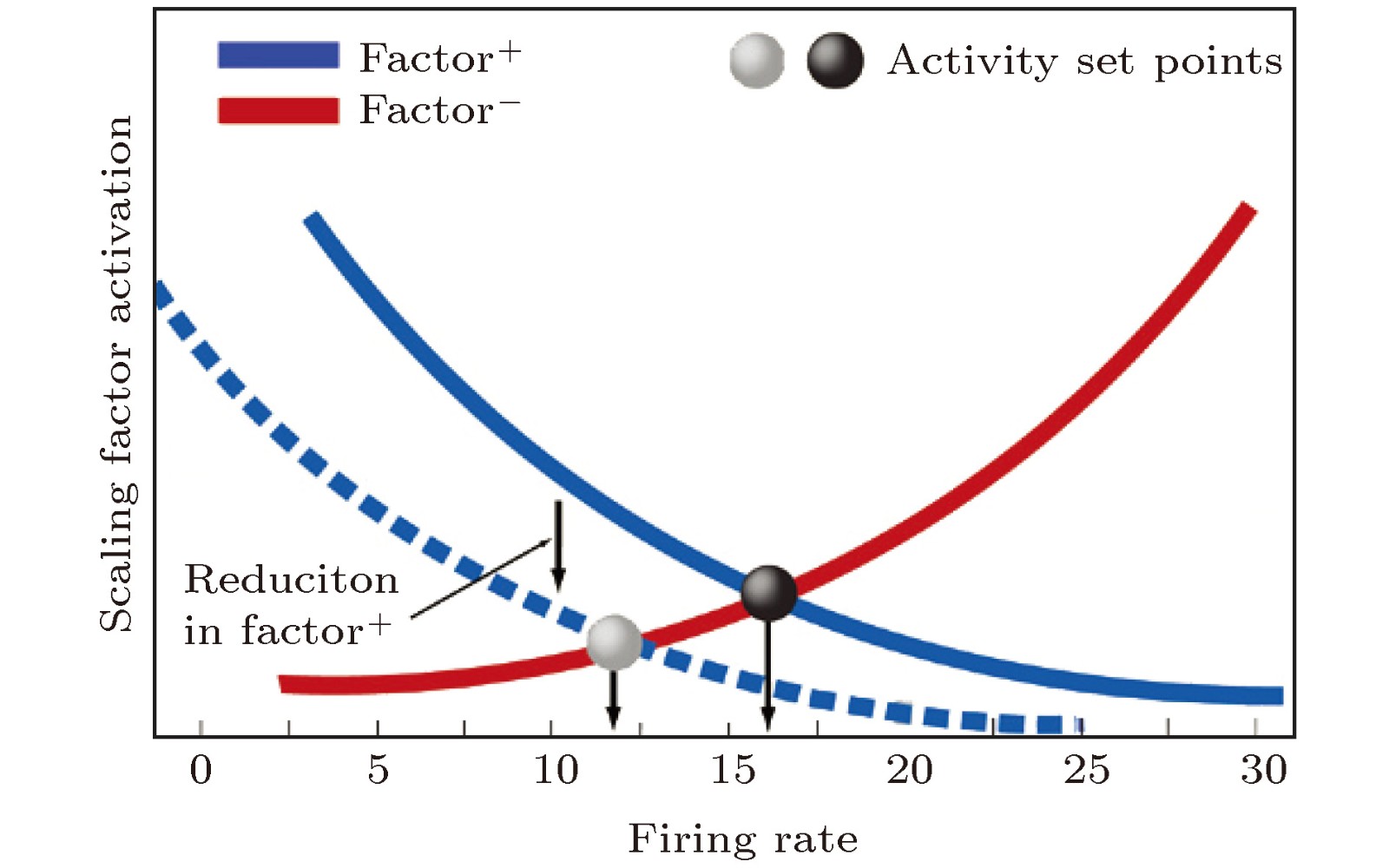-
Neural firing rate homeostasis, as an important feature of neural electrical activity, means that the firing rate in brain is maintained in a relatively stable state, and fluctuates around a constant value. Extensive experimental studies have revealed that the firing rate homeostasis is ubiquitous in brain, and provides a base for neural information processing and maintaining normal neurological functions, so that the research on neural firing rate homeostasis is a central problem in the field of neuroscience. Cortical neural network is a highly complex dynamic system with a large number of input disturbance signals and parameter perturbations due to dynamic connection. However, it remains to be further investigated how firing rate homeostasis is established in cortical neural network, furthermore, maintains robustness to these disturbances and perturbations. The feedback neural circuit with recurrent excitatory and inhibitory connection is a typical connective pattern in cortical cortex, and inhibitory synaptic plasticity plays a crucial role in achieving neural firing rate homeostasis. Here, by constructing a feedback neural network with inhibitory spike timing-dependent plasticity (STDP), we conduct a computational research to elucidate the mechanism of neural firing rate homeostasis. The results indicate that the neuronal firing rate can track the target firing rate accurately under the regulation of inhibitory synaptic plasticity, thus achieve firing rate homeostasis. In the face of external disturbances and parameter perturbations, the neuron firing rate deviates transiently from the target firing rate value, and converges to the target firing rate value at a steady state, which demonstrates that the firing rate homeostasis established by the inhibitory synaptic plasticity can maintain strong robustness. Furthermore, the analytical research qualitatively explains the firing rate homeostasis mechanism underlined by inhibitory synaptic plasticity. Finally, the simulations further demonstrate that the learning rate value and the firing rate set point value also exert a quantitative influence on the firing rate homeostasis. Overall, these findings not only gain an insight into the firing rate homeostasis mechanism underlined by inhibitory synaptic plasticity, but also inspire testable hypotheses for future experimental studies.
-
Keywords:
- inhibitory synaptic plasticity /
- firing rate homeostasis /
- robustness
[1] Gläser C, Joublin F 2011 IEEE T. Auton. Ment. De. 3 285
 Google Scholar
Google Scholar
[2] Hengen K B, Lambo M E, Hooser S D, van Katz D B, Turrigiano G G 2013 Neuron 80 335
 Google Scholar
Google Scholar
[3] Corner M A, Ramakers G J A 1992 Dev. Brain Res. 65 57
 Google Scholar
Google Scholar
[4] Ramakers G J A, Corner M A, Habets A M M C 1990 Exp. Brain Res. 79 157
 Google Scholar
Google Scholar
[5] Ramakers G J A, Galen H V, Feenstra M G P, Corner M A, Boer G J 1994 Int. J. Dev. Neurosci. 12 611
 Google Scholar
Google Scholar
[6] Pol A N V D, Obrietan K, Belousov A 1996 Neuroscience 74 653
 Google Scholar
Google Scholar
[7] Turrigiano G G, Leslie K R, Desai N S, Rutherford L C, Nelson S B 1998 Nature 391 892
 Google Scholar
Google Scholar
[8] Rutherford L C, Nelson S B, Turrigiano G G 1998 Neuron 21 521
 Google Scholar
Google Scholar
[9] Burrone J, O'Byrne M, Murthy V N 2002 Nature 420 414
 Google Scholar
Google Scholar
[10] Turrigiano G G, Nelson S B 2004 Nat. Rev. Neurosci. 5 97
 Google Scholar
Google Scholar
[11] Turrigiano G 2012 CSH Perspect. Biol. 4 a005736
 Google Scholar
Google Scholar
[12] Cannon J, Miller P 2016 J. Neurophysiol. 116 2004
 Google Scholar
Google Scholar
[13] Cannon J, Miller P 2017 J. Math. Neurosc. 7 1
 Google Scholar
Google Scholar
[14] Miller P, Cannon J 2018 Biol. Cybern. 113 47
[15] McClelland J L, McNaughton B L, O'Reilly R C 1995 Psychol. Rev. 102 419
 Google Scholar
Google Scholar
[16] Frankland P W, O'Brien C, Ohno M, Kirkwood A, Silva A J 2001 Nature 411 309
 Google Scholar
Google Scholar
[17] Carcea I, Froemke R C 2013 Prog. Brain. Res. 207 65
 Google Scholar
Google Scholar
[18] Martin S J, Grimwood P D, Morris R G M 2000 Annu. Rev. Neurosci. 23 649
 Google Scholar
Google Scholar
[19] Sanderson J L, Dell'Acqua M L 2011 Neuroscientist 17 321
 Google Scholar
Google Scholar
[20] Yong L, Kauer J A 2010 Synapse 51 1
 Google Scholar
Google Scholar
[21] Haas J S, Thomas N, Abarbanel H D I 2006 J. Neurophysiol. 96 3305
 Google Scholar
Google Scholar
[22] D'Amour J A, Froemke R C 2015 Neuron 86 514
 Google Scholar
Google Scholar
[23] Hartmann K, Bruehl C, Golovko T, Draguhn A 2008 Plos One 3 e2979
 Google Scholar
Google Scholar
[24] Tohru K, Kazumasa Y, Yumiko Y, Crair M C, Yukio K 2008 Neuron 57 905
 Google Scholar
Google Scholar
[25] Stephen G, James R W 2001 Cereb. Cortex 11 37
 Google Scholar
Google Scholar
[26] Luz Y, Shamir M 2012 Plos. Comput. Biol. 8 e1002334
 Google Scholar
Google Scholar
[27] Hennequin G, Agnes E J, Vogels T P 2017 Annu. Revi. Neurosci. 40 557
 Google Scholar
Google Scholar
[28] Park H J, Friston K 2013 Science 342 1238411
 Google Scholar
Google Scholar
[29] Isaacson J S, Massimo S 2011 Neuronv 72 231
 Google Scholar
Google Scholar
[30] Maass W, Joshi P, Sontag E D 2007 Plos Comput. Biol. 3 e165
 Google Scholar
Google Scholar
[31] Jansen B H, Rit V G 1995 Biol. Cybern. 73 357
 Google Scholar
Google Scholar
[32] Chacron M J, André L, Leonard M 2005 Phys. Rev. E 72 051917
 Google Scholar
Google Scholar
[33] Froemke R C, Jones B J 2011 Neurosci. Biobehav. R. 35 2105
 Google Scholar
Google Scholar
[34] 王俊松, 徐瑶 2014 63 068701
 Google Scholar
Google Scholar
Wang J S, Xu Y 2014 Acta Phys. Sin. 63 068701
 Google Scholar
Google Scholar
[35] 王美丽, 王俊松 2015 64 108701
 Google Scholar
Google Scholar
Wang M L, Wang J S 2015 Acta Phys. Sin. 64 108701
 Google Scholar
Google Scholar
[36] Vogels T P, Abbott L F 2009 Nat. Neurosci. 12 483
 Google Scholar
Google Scholar
[37] Stepp N, Plenz D, Srinivasa N 2015 Plos Comput. Biol. 11 e1004043
 Google Scholar
Google Scholar
[38] Vogels T P, Sprekeler H, Zenke F, Clopath C, Gerstner W 2011 Science 334 1569
 Google Scholar
Google Scholar
[39] Maass W 2014 P. IEEE 102 860
 Google Scholar
Google Scholar
[40] Mcdonnell M D, Ward L M 2011 Nat. Rev. Neurosci. 12 183
 Google Scholar
Google Scholar
[41] Garrett D D, Mcintosh A R, Grady C L 2011 Nat. Rev. Neurosci. 12 612
 Google Scholar
Google Scholar
[42] Mcdonnell M D, Ward L M 2011 Nat. Rev. Neurosci. 12 415
 Google Scholar
Google Scholar
[43] Turrigiano G G 2008 Cell 135 422
 Google Scholar
Google Scholar
[44] Marder E, Tang L S 2010 Neuron 66 161
 Google Scholar
Google Scholar
[45] Sharon B, Dickman D K, Davis G W 2010 Neuron 66 220
 Google Scholar
Google Scholar
-
图 9 参数摄动下的放电率自稳态鲁棒性 (a)参数摄动信号; (b)神经元膜电位; (c)神经元平均放电率曲线; (d)抑制性突触权重变化曲线
Figure 9. The robustness of neural firing rate homeostasis under parameter perturbation: (a) The parameter perturbation signal; (b) neuronal membrane potential; (c) the average firing rate; (d) the strength of inhibitory synapse.
图 10 参数干扰时有无抑制性突触可塑性两种情况下的神经元平均放电率自稳态特性 (a)参数摄动信号; (b)神经元膜电位; (c)神经元平均放电率曲线; (d)抑制性突触权重变化曲线
Figure 10. The firing rate characteristics with and without inhibitory synaptic plasticity under parameter perturbation: (a) The parameter perturbation signal; (b) neural membrane potential; (c) the average firing rate; (d) the strength of inhibitory synapse.
表 1 神经网络结构相关参数取值
Table 1. Parameters values of the neural feedback model structure.
参数 描述 取值 NE 兴奋性神经元规模 800 NI 抑制性神经元规模 200 PEE E-E的连接概率 0.2 PEI E-I的连接概率 0.4 PIE I-E的连接概率 0.4 PII I-I的连接概率 0.4 表 2 神经元模型各参数取值
Table 2. Parameters values of LIF neuron model.
参数 取值 单位 ${\tau _{\rm{m}}}$ 20 ms ${V^{{\rm{rest}}}}$ –60 mV ${V_{{\rm{th}}}}$ –50 mV ${V^{\rm{E}}}$ 0 mV ${V^{\rm{I}}}$ –70 mV ${g^{{\rm{leak}}}}$ 10 nS 表 3 突触模型参数取值
Table 3. Parameters values of synapse model.
参数 取值 单位 ${\tau _{\rm{E}}}$ 5 ms ${\tau _{\rm{I}}}$ 10 ms ${\bar g^{\rm{E}}}$ 140 pS ${\bar g^{\rm{I}}}\normalsize$ 350 pS 表 4 抑制性突触可塑性的参数取值
Table 4. Parameters values of inhibitory synaptic plasticity.
参数 描述 取值 ${W_{ij}}^{}$ 抑制性突触权重 0 ${\tau _{{\rm{STDP}}}}$ 可塑性时间常数 20 $\eta $ 学习率 0.005 $\alpha $ 抑制因子 0.12 ${\rho _0}\normalsize$ 目标放电率 -
[1] Gläser C, Joublin F 2011 IEEE T. Auton. Ment. De. 3 285
 Google Scholar
Google Scholar
[2] Hengen K B, Lambo M E, Hooser S D, van Katz D B, Turrigiano G G 2013 Neuron 80 335
 Google Scholar
Google Scholar
[3] Corner M A, Ramakers G J A 1992 Dev. Brain Res. 65 57
 Google Scholar
Google Scholar
[4] Ramakers G J A, Corner M A, Habets A M M C 1990 Exp. Brain Res. 79 157
 Google Scholar
Google Scholar
[5] Ramakers G J A, Galen H V, Feenstra M G P, Corner M A, Boer G J 1994 Int. J. Dev. Neurosci. 12 611
 Google Scholar
Google Scholar
[6] Pol A N V D, Obrietan K, Belousov A 1996 Neuroscience 74 653
 Google Scholar
Google Scholar
[7] Turrigiano G G, Leslie K R, Desai N S, Rutherford L C, Nelson S B 1998 Nature 391 892
 Google Scholar
Google Scholar
[8] Rutherford L C, Nelson S B, Turrigiano G G 1998 Neuron 21 521
 Google Scholar
Google Scholar
[9] Burrone J, O'Byrne M, Murthy V N 2002 Nature 420 414
 Google Scholar
Google Scholar
[10] Turrigiano G G, Nelson S B 2004 Nat. Rev. Neurosci. 5 97
 Google Scholar
Google Scholar
[11] Turrigiano G 2012 CSH Perspect. Biol. 4 a005736
 Google Scholar
Google Scholar
[12] Cannon J, Miller P 2016 J. Neurophysiol. 116 2004
 Google Scholar
Google Scholar
[13] Cannon J, Miller P 2017 J. Math. Neurosc. 7 1
 Google Scholar
Google Scholar
[14] Miller P, Cannon J 2018 Biol. Cybern. 113 47
[15] McClelland J L, McNaughton B L, O'Reilly R C 1995 Psychol. Rev. 102 419
 Google Scholar
Google Scholar
[16] Frankland P W, O'Brien C, Ohno M, Kirkwood A, Silva A J 2001 Nature 411 309
 Google Scholar
Google Scholar
[17] Carcea I, Froemke R C 2013 Prog. Brain. Res. 207 65
 Google Scholar
Google Scholar
[18] Martin S J, Grimwood P D, Morris R G M 2000 Annu. Rev. Neurosci. 23 649
 Google Scholar
Google Scholar
[19] Sanderson J L, Dell'Acqua M L 2011 Neuroscientist 17 321
 Google Scholar
Google Scholar
[20] Yong L, Kauer J A 2010 Synapse 51 1
 Google Scholar
Google Scholar
[21] Haas J S, Thomas N, Abarbanel H D I 2006 J. Neurophysiol. 96 3305
 Google Scholar
Google Scholar
[22] D'Amour J A, Froemke R C 2015 Neuron 86 514
 Google Scholar
Google Scholar
[23] Hartmann K, Bruehl C, Golovko T, Draguhn A 2008 Plos One 3 e2979
 Google Scholar
Google Scholar
[24] Tohru K, Kazumasa Y, Yumiko Y, Crair M C, Yukio K 2008 Neuron 57 905
 Google Scholar
Google Scholar
[25] Stephen G, James R W 2001 Cereb. Cortex 11 37
 Google Scholar
Google Scholar
[26] Luz Y, Shamir M 2012 Plos. Comput. Biol. 8 e1002334
 Google Scholar
Google Scholar
[27] Hennequin G, Agnes E J, Vogels T P 2017 Annu. Revi. Neurosci. 40 557
 Google Scholar
Google Scholar
[28] Park H J, Friston K 2013 Science 342 1238411
 Google Scholar
Google Scholar
[29] Isaacson J S, Massimo S 2011 Neuronv 72 231
 Google Scholar
Google Scholar
[30] Maass W, Joshi P, Sontag E D 2007 Plos Comput. Biol. 3 e165
 Google Scholar
Google Scholar
[31] Jansen B H, Rit V G 1995 Biol. Cybern. 73 357
 Google Scholar
Google Scholar
[32] Chacron M J, André L, Leonard M 2005 Phys. Rev. E 72 051917
 Google Scholar
Google Scholar
[33] Froemke R C, Jones B J 2011 Neurosci. Biobehav. R. 35 2105
 Google Scholar
Google Scholar
[34] 王俊松, 徐瑶 2014 63 068701
 Google Scholar
Google Scholar
Wang J S, Xu Y 2014 Acta Phys. Sin. 63 068701
 Google Scholar
Google Scholar
[35] 王美丽, 王俊松 2015 64 108701
 Google Scholar
Google Scholar
Wang M L, Wang J S 2015 Acta Phys. Sin. 64 108701
 Google Scholar
Google Scholar
[36] Vogels T P, Abbott L F 2009 Nat. Neurosci. 12 483
 Google Scholar
Google Scholar
[37] Stepp N, Plenz D, Srinivasa N 2015 Plos Comput. Biol. 11 e1004043
 Google Scholar
Google Scholar
[38] Vogels T P, Sprekeler H, Zenke F, Clopath C, Gerstner W 2011 Science 334 1569
 Google Scholar
Google Scholar
[39] Maass W 2014 P. IEEE 102 860
 Google Scholar
Google Scholar
[40] Mcdonnell M D, Ward L M 2011 Nat. Rev. Neurosci. 12 183
 Google Scholar
Google Scholar
[41] Garrett D D, Mcintosh A R, Grady C L 2011 Nat. Rev. Neurosci. 12 612
 Google Scholar
Google Scholar
[42] Mcdonnell M D, Ward L M 2011 Nat. Rev. Neurosci. 12 415
 Google Scholar
Google Scholar
[43] Turrigiano G G 2008 Cell 135 422
 Google Scholar
Google Scholar
[44] Marder E, Tang L S 2010 Neuron 66 161
 Google Scholar
Google Scholar
[45] Sharon B, Dickman D K, Davis G W 2010 Neuron 66 220
 Google Scholar
Google Scholar
Catalog
Metrics
- Abstract views: 12980
- PDF Downloads: 140
- Cited By: 0















 DownLoad:
DownLoad:
